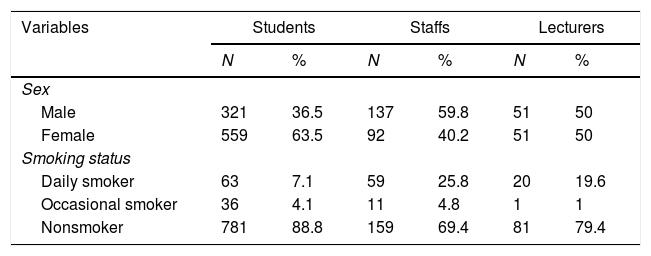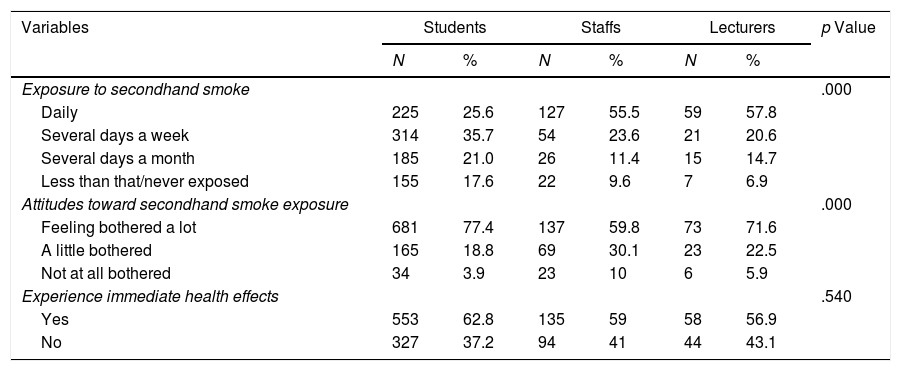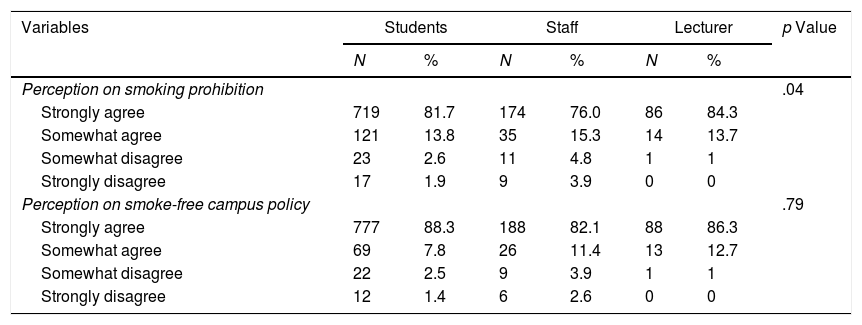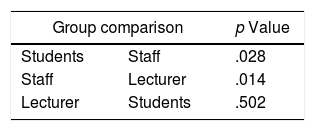The aim of this study was to identify the perception of students, lecturers and staffs on smoke-free campus policy.
MethodSamples, including 880 students, 102 lecturers and 209 staff, were taken from all faculties in Universitas Riau using convenience sampling technique. A survey was conducted for these respondents through the distribution of questionnaires. Information pertaining to demographics, smoking and non-smoking behaviors and experiences, and perceptions regarding smoke-free campus policy was obtained.
ResultsIt was discovered that 58% of survey groups and respondents were females, 84.3% were non-smokers, and 66.1% reported exposure to cigarette smoke in university campus every day or several days in a week. All groups reported that they were affected by cigarette smoking with no significant difference in the proportion (p=.540). The rate of students and lecturers were similar in terms of their agreements on smoking prohibition in campus environment (81.7% and 84.3% respectively), while it was different with staff (p=.004). Further ANOVA analysis revealed that there was a significant difference between groups regarding agreements on smoking prohibition (p=.007) such that staff differed from lecturers and students (p=.014 and p=.028), while lecturers and students showed no significant difference (p=.502). All groups strongly agreed on establishing a smoke-free campus (81.9% of students, 85.3% of lecturers, 77.7% of staffs) with no significant difference in their proportion (p=.079).
ConclusionsInterventions can be introduced to enhance support gotten from the staff group, however, majority of the students, lecturers and staffs were very supportive of creating a smoke-free campus. Therefore, there is a call to action for university leaders and decision makers to implement the policy.
Smoking behavior is popular for its negative impacts on public health. Smokes from cigarette harm almost every organ in the human body, cause a decline in overall health status and increase costs of treatment.1,2 Moreover, it is not only harmful to the smokers, but also to people that are exposed to second-hand smoke.2
There is no threshold or safety limit to second-hand smoke (SHS) exposure. Even occasional exposure can lead to cardiovascular and respiratory disease as well as lung and different types of cancers.1–3 World Health Organization suggests that the only intervention that has proved successful in protecting people from this is the implementation of a smoke-free environment.4
In order to achieve high compliance and strong public support, it is important for governments to enact and enforce smoke-free laws.5 In Indonesia, there have been different regulations about smoke-free environment since 2012. Places such as health care, teaching and learning facilities, children playing areas, places of worship, public transport, workplace, and other public places should be smoke-free areas.6
Universities and campuses as teaching and learning facilities are all encouraged to adopt this policy. Several studies have reported that the successful implementation of smoke-free campus policy has reduced the number of active and passive smokers in campus environment.7,8 This is because the environment discourages smokers from smoking as they used to and also helps them in making a quit attempt, therefore, increasing the rates of long term quit.9
Universitas Riau, a major university in Riau province, Indonesia, has not implemented smoke-free environment yet. Previous study revealed that students were not opposed to prohibition of smoking in campus area. Instead, they expect the university administrators to implement smoke-free campus policy.10
A follow-up study is needed to identify perceptions of other university members, including lecturers and staff as regards this policy. Therefore, this study was aimed at identifying and comparing the perceptions of students, lecturers and staffs on smoke-free campus policy.
MethodsA survey was conducted between July and October 2016 to identify the perceptions of students, lecturers and staffs regarding the establishment of a smoke-free policy in Universitas Riau. A set of questionnaires containing 18 quantitative questions was distributed throughout the university. Information pertaining to demographics, smoking and non-smoking behaviors and experiences, and perceptions regarding smoke-free campus policy was obtained.
The questionnaire was developed in accordance with a survey conducted by the University of Michigan Tobacco Research Network. The first part of the questionnaire contained demographic characteristics of the respondents including gender, affiliation to the university, and smoking status. The next four questions were to identify perceptions on passive smoking, three questions regarding attitudes toward smoke-free campus policy, and three questions to identify active smokers. The rest of the quantitative questions were targeted toward exploring different ways of receiving health information. The last part was a qualitative question to explore thoughts and perceptions of the respondents.
Approval was gotten from the Rector of the school prior to the conduct of the survey. A total of 1211 individuals including 880 students, 229 staffs and 102 lecturers agreed to participate in this study. These samples were estimated to represent 30%, 20% and 10% of total students, staffs, and lecturers respectively. They were conveniently recruited from all schools and faculties in the university.
Computer software was used to analyze data in order to obtain the frequency distribution. Chi-square and ANOVA test were both used to compare rate and explore the difference between each group in details.
ResultsThe results showed that 58% of all respondents were females and that 84.3% were non-smokers. Table 1 shows that majority of the students were female (63.5%), staffs were mostly male (59.8%) and there was gender balance for the representation of the lecturers. It was also discovered that the majority of the respondents from all groups were nonsmokers, just 25.8% of staffs and 19.6% of lecturers were daily smokers.
As regards experiences and perceptions on secondhand smoke, 66.1% reported exposure to cigarette smoke on the campus every day or several days in a week. Majority of the respondents (73.6%) were bothered a lot about the smoke and 61.6% experience immediate health effects such as cough and difficulty in breathing.
Table 2 shows that more lecturers and staffs got exposed to secondhand smoke; however, more students reported immediate health effects after exposure. All groups reported they were affected by cigarette smoke with no significant difference in the proportion (p=.540).
Experiences and perceptions on secondhand smoke (n=1211).
| Variables | Students | Staffs | Lecturers | p Value | |||
|---|---|---|---|---|---|---|---|
| N | % | N | % | N | % | ||
| Exposure to secondhand smoke | .000 | ||||||
| Daily | 225 | 25.6 | 127 | 55.5 | 59 | 57.8 | |
| Several days a week | 314 | 35.7 | 54 | 23.6 | 21 | 20.6 | |
| Several days a month | 185 | 21.0 | 26 | 11.4 | 15 | 14.7 | |
| Less than that/never exposed | 155 | 17.6 | 22 | 9.6 | 7 | 6.9 | |
| Attitudes toward secondhand smoke exposure | .000 | ||||||
| Feeling bothered a lot | 681 | 77.4 | 137 | 59.8 | 73 | 71.6 | |
| A little bothered | 165 | 18.8 | 69 | 30.1 | 23 | 22.5 | |
| Not at all bothered | 34 | 3.9 | 23 | 10 | 6 | 5.9 | |
| Experience immediate health effects | .540 | ||||||
| Yes | 553 | 62.8 | 135 | 59 | 58 | 56.9 | |
| No | 327 | 37.2 | 94 | 41 | 44 | 43.1 | |
Table 3 shows that majority of students and lecturers agreed that smoking must be prohibited on campus (81.7% and 84.3% respectively), while there was a difference with staffs (p=.004). All groups strongly agreed on the establishment of a smoke-free campus (81.9% of students, 85.3% of lecturers, 77.7% of staffs) with no difference in the proportion (p=.079).
Perceptions on smoking prohibition and smoke-free campus (n=1211).
| Variables | Students | Staff | Lecturer | p Value | |||
|---|---|---|---|---|---|---|---|
| N | % | N | % | N | % | ||
| Perception on smoking prohibition | .04 | ||||||
| Strongly agree | 719 | 81.7 | 174 | 76.0 | 86 | 84.3 | |
| Somewhat agree | 121 | 13.8 | 35 | 15.3 | 14 | 13.7 | |
| Somewhat disagree | 23 | 2.6 | 11 | 4.8 | 1 | 1 | |
| Strongly disagree | 17 | 1.9 | 9 | 3.9 | 0 | 0 | |
| Perception on smoke-free campus policy | .79 | ||||||
| Strongly agree | 777 | 88.3 | 188 | 82.1 | 88 | 86.3 | |
| Somewhat agree | 69 | 7.8 | 26 | 11.4 | 13 | 12.7 | |
| Somewhat disagree | 22 | 2.5 | 9 | 3.9 | 1 | 1 | |
| Strongly disagree | 12 | 1.4 | 6 | 2.6 | 0 | 0 | |
Further ANOVA analysis showed that there was a significant difference between the groups as regards agreements on smoking prohibition (p=.007). Table 4 shows that the staffs differed from lecturers and students (p=.014 and p=.028), while no significant difference was observed among lecturers and students (p=.502).
DiscussionThe results showed that females and nonsmokers were the majority group among the respondents and that they are predictors to smoke-free policy support.11,12 Before the implementation of the policy, smokers tend to be less supportive compare to nonsmokers.7
Most respondents reported frequent exposure and were being bothered about secondhand smoke in campus environment. Evidence points to the fact that students and faculty members were most exposed to SHS in campus, and that outdoor exposure is difficult to avoid.7 While staffs and lecturers in this study reported more exposure, more students expressed being bothered by the smoke and are more susceptible to experience immediate health effects. Since the health consequences of being a passive smoker have been widely studied and stated, a study suggested that more research should be conducted into the importance of public health issues and the harms of tobacco with regards to approval of tobacco policies.13
There were differences in the perceptions of three groups on smoking prohibition in campus environment. While the students and lecturers agreed to it, staffs were less likely to favor it. These findings contradict other evidence where staffs were not less receptive to smoking prohibition.13,14 Therefore, further investigation is needed in this case.
Despite the fact that there were variations in the proportions, all the groups agreed that smoke-free campus policy should be implemented. This will help in reducing the number of active and passive smokers on the campus.7,8,15 A study found that university members believed exposure to smoke was harmful to their health, therefore, university administrators should ensure that the campus community is protected from secondhand smoke.16
This current study has certain limitations. Several factors such as the reliance on self-reported instrument and non-application of random sampling could lead to potential bias. In addition, it did not also consider some demographic factors that may affect perceptions on the policy.
ConclusionIt can be concluded that the university members were not opposed to smoke-free campus policy although there might be need for interventions to enhance support from staff group. The results of this study provide a sound basis for university leaders and decision makers to implement smoke-free campus policy. A follow-up study should be carried out to explore the health effects and certain characteristics relating to the receptiveness of this policy.
This research was funded by the Ministry of Research, Technology and Higher Education.
Peer-review of abstracts of the articles is under the responsibility of the Scientific Committee of Riau International Nursing Conference 2018. Full-text and the content of it is under responsibility of authors of the article.










